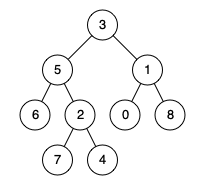236. Lowest Common Ancestor of a Binary Tree (Medium)
https://leetcode.com/problems/lowest-common-ancestor-of-a-binary-tree/
Given a binary tree, find the lowest common ancestor (LCA) of two given nodes in the tree.
According to the definition of LCA on Wikipedia: “The lowest common ancestor is defined between two nodes p and q as the lowest node in T that has both p and q as descendants (where we allow a node to be a descendant of itself).”
Given the following binary tree: root = [3,5,1,6,2,0,8,null,null,7,4]

Example 1:
Input: root = [3,5,1,6,2,0,8,null,null,7,4], p = 5, q = 1 Output: 3 Explanation: The LCA of nodes5and1is3.
Example 2:
Input: root = [3,5,1,6,2,0,8,null,null,7,4], p = 5, q = 4 Output: 5 Explanation: The LCA of nodes5and4is5, since a node can be a descendant of itself according to the LCA definition.
Note:
- All of the nodes' values will be unique.
- p and q are different and both values will exist in the binary tree.
Solutions
1.
class Solution {
private TreeNode ans;
public Solution() {
// Variable to store LCA node.
this.ans = null;
}
private boolean recurseTree(TreeNode currentNode, TreeNode p, TreeNode q) {
// If reached the end of a branch, return false.
if (currentNode == null) {
return false;
}
// Left Recursion. If left recursion find either node, set left = 1 else 0
int left = this.recurseTree(currentNode.left, p, q) ? 1 : 0;
// Right Recursion
int right = this.recurseTree(currentNode.right, p, q) ? 1 : 0;
// If the current node is one of p or q, or p and q are the same node
int mid = (currentNode.val == p.val) ? 1 : 0;
mid += (currentNode.val == q.val) ? 1 : 0;
// Both nodes are found under node 'currentNode', there are four situations
// 1. left and right
// 2. left and mid
// 3. right and mid
// 4. mid and mid
if (mid + left + right >= 2) {
// Only the lowest parent can set this value, which means only the direct
// parent can make the sum mid + left + right >= 2.
// So here we don't have to check if this.ans is null;
this.ans = currentNode;
}
// Return true if any one of the three bool values is True.
return (mid + left + right > 0);
}
public TreeNode lowestCommonAncestor(TreeNode root, TreeNode p, TreeNode q) {
// Traverse the tree
this.recurseTree(root, p, q);
return this.ans;
}
}
2.
class Solution {
// This solution does not take one special situation into consideration. That is p
// and q are the same node.
private TreeNode ans;
public Solution() {
// Variable to store LCA node.
this.ans = null;
}
private boolean recurseTree(TreeNode currentNode, TreeNode p, TreeNode q) {
// If reached the end of a branch, return false.
if (currentNode == null) {
return false;
}
// Left Recursion. If left recursion returns true, set left = 1 else 0
int left = this.recurseTree(currentNode.left, p, q) ? 1 : 0;
// Right Recursion
int right = this.recurseTree(currentNode.right, p, q) ? 1 : 0;
// If the current node is one of p or q
// It is better to compare the value instead of the object.
int mid = (currentNode == p || currentNode == q) ? 1 : 0;
// If any two of the flags left, right or mid become True
if (mid + left + right >= 2) {
this.ans = currentNode;
}
// Return true if any one of the three bool values is True.
return (mid + left + right > 0);
}
public TreeNode lowestCommonAncestor(TreeNode root, TreeNode p, TreeNode q) {
// Traverse the tree
this.recurseTree(root, p, q);
return this.ans;
}
}